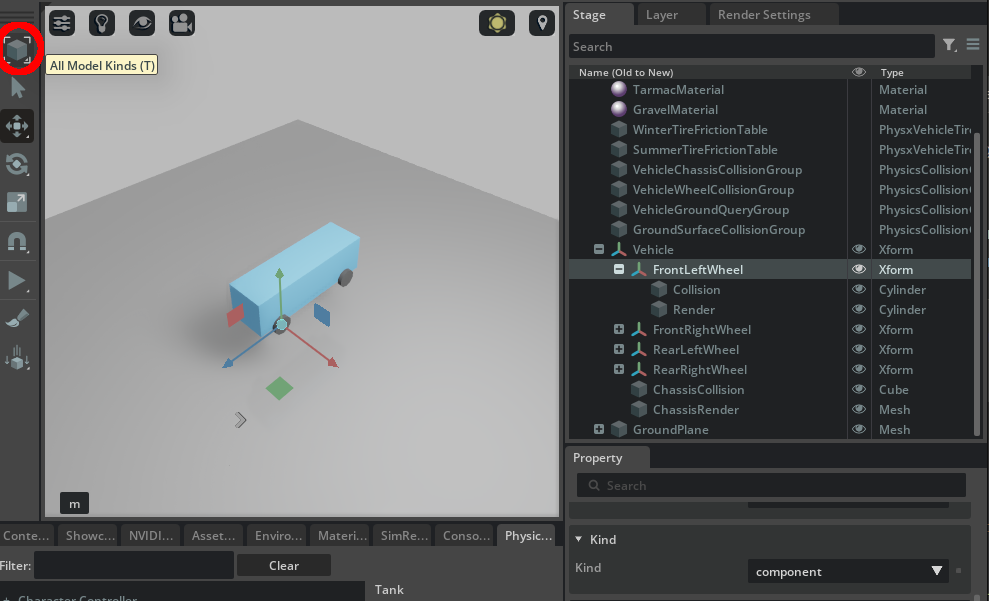Kind
The kind metadata can be authored via UsdModelAPI and it is often used to tag a prim:
def Xform "CameraMesh" (
hide_in_stage_window = true # some metadata
kind = "subcomponent" # kind metadata
no_delete = true # some more metadata
)
{
# usual rest of prim properties
bool primvars:doNotCastShadows = 1
bool primvars:omni:kit:isGizmo = 1
...
}
and is mainly used for two things:
-
During traversals you might want to detect where a complete 3D model hierarchy starts (i.e. the topmost parent of the self-contained 3D asset model), or where a custom-tagged sub-hierarchy of prims starts
from pxr import Sdf, UsdGeom, Usd, UsdLux, Gf, Kind import omni.usd import carb # Function to generate a random identifier and make the sibling prim names unique def generate_random_identifier(length=5): return ''.join(random.choice(string.ascii_letters) for _ in range(length)) BASE_DIRECTORY = "/tmp" # This is where the .usda files will be saved stage : Usd.Stage = Usd.Stage.CreateInMemory("RootLayer.usda") xform : UsdGeom.Xform = UsdGeom.Xform.Define(stage, Sdf.Path("/World")) environment_xform = UsdGeom.Xform.Define(stage, "/World/Environment") dome_light = UsdLux.DomeLight.Define(stage, "/World/Environment/DomeLight") dome_light.CreateIntensityAttr(1000) model_prim = stage.DefinePrim("/World/ThisIsAModel", "Xform") model_API = Usd.ModelAPI(model_prim) model_API.SetKind(Kind.Tokens.model) custom_prim = stage.DefinePrim("/World/ThisIsACustomKind", "Xform") model_API = Usd.ModelAPI(custom_prim) model_API.SetKind("custom") """ prim /World/ThisIsAModel has kind: model prim /World/ThisIsACustomKind has kind: custom """ for prim in stage.Traverse(): kind = Usd.ModelAPI(prim).GetKind() if kind: print(f"prim {str(prim.GetPath())} has kind: {kind}") stage.GetRootLayer().Export(BASE_DIRECTORY + "/RootLayer.usda") omni.usd.get_context().open_stage(BASE_DIRECTORY + "/RootLayer.usda")There are also
UsdPrim::IsModelandUsdPrim::IsGrouppredicates that can be used during stage traversals (since they’re very commonly used). -
DCCs (digital content creation programs) that use USD might have a custom UI selection mode to facilitate the user in selecting something in their viewport. OV Composer uses this to switch between a
select_any_prim_under_the_cursorand aselect_only_model_prims_under_the_cursor
This is better documented in the selection modes documentation for OV Composer; the same applies for any other DCC which uses USD and the kind selection mode switch.
If you’re developing a USD Omniverse connector or working in USD within a DCC you can define your own tags and register them via the plugin system. The default ones in OV Composer have usually the following meaning
| Kind | Description |
|---|---|
| model | This shouldn’t be used directly as it’s the base kind for all models |
| assembly | In a USD file representing a scene this is usually the kind of the topmost prim. This kind should be used for published (i.e. shared with other artists) assets which aggregate other published components or assemblies together. Assemblies can sometimes override materials on individual components to better visually integrate them together. |
| group | A group of 3D models. These are usually the intermediate Xforms under an assembly. It shouldn’t be used on the root of published assets since they’re helper kinds. |
| component | The most basic asset published in a USD pipeline: it can be at the root prim of an asset and should not reference external geometries or models. The main difference between an assembly and a component is that an assembly can be made of more components and reference outside stuff as well. A component is self-contained. |
| subcomponent | A subcomponent is usually a Xformable prim within a component model intentionally made available to apply some transformation. |
This is a ten-thousand feet overview but if you’re interested into learning more there are in-depth documents in the usd-wg repo on the subject.